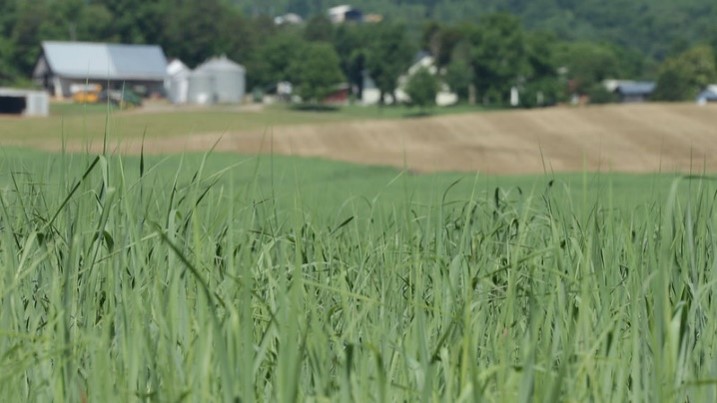The Biomass Research and Development Board's Feedstock Genetic Improvement Working Group’s mission is to advise, communicate, and coordinate federal research activities relative to the genetic improvement of terrestrial feedstocks, primarily cellulosic biomass and oilseeds, as sustainable sources of bio-based fuels and bioproducts.
The working group's goal is to further development of superior, dedicated feedstocks using the tools of genetics and genomics for the implementation of innovative feedstock breeding programs.

What Is Feedstock Genetic Improvement?
Feedstock genetic improvement activities overcome the biological barriers to the low-cost, high-quality, scalable, and sustainable production of biomass for feedstocks. Examples of genetic improvements include:
- Research into the molecular mechanisms and processes underlying key bioenergy crop traits
- Classical and advanced plant breeding, including plant genetic and genome engineering
- Regional crop adaptation and production.
Why Is this Important for the Bioeconomy?
Understanding and controlling genes and gene networks that affect how plant cells function may result in bioenergy crops with enhanced biomass production. These enhanced crops may be amenable to breakdown and conversion to biofuels and bioproducts.
Federal coordination on research activities related to the genetic improvement of terrestrial feedstocks, primarily cellulosic biomass and oilseeds, as sustainable sources of bio-based fuels and bioproducts saves money and can lead to feedstock improvements more rapidly.
Click here1 to watch a short video on the topic of plant breeding to improve the yield and sustainability of switchgrass.
What Are the U.S. Government’s Goals for Feedstock Genetic Improvement?
Some of the federal government goals for genetic improvement of terrestrial feedstocks include:
- Developing productive, high yielding, regionally adapted biomass and oilseed crops for cost-competitive production of biofuels and bioproducts
- Establishing a fully developed biofuel and bioproducts production pipeline, from basic science to translation of improved feedstocks, commercial deployment, and production
- Supporting a stable policy and regulatory process regarding growth of biotech crops that provides confidence in marketable products, as well as consumer confidence in their safety.
What Progress Has Occurred?
Scientists at universities, federally funded facilities, and in private industry in partnership with the federal government continue to improve biomass feedstocks. Below are several recent examples of successful research:
- The U.S. Department of Agriculture–Agricultural Research Service (USDA–ARS)2 scientists and university collaborators have demonstrated that upland and lowland cultivars of switchgrass can differ in their ability to withstand attack by plant pathogens. This research also demonstrated that different genes may provide rust resistance in northern plantings compared to southern plantings.
- The U.S. Department of Energy's Bioenergy Research Center, Center of Bioenergy Innovation3 showed that overexpression of a Prefoldin β subunit gene increases the total released sugar (glucose and xylose) amounts and alters lignin composition in poplar, a bioenergy crop. These results suggest that overexpression of this Prefoldin gene may reduce biomass recalcitrance and is a promising target for genetic engineering to improve feedstock characteristics to enhance biofuel conversion and reduce the cost of lignocellulosic biofuel production.
- USDA-ARS4 scientists and university collaborators published in the journal Plant Molecular Biology demonstrated that lignin composition can be altered in sorghum without significantly impacting the growth or biomass yield of the plants, which is a necessary feature for future bioenergy applications
References
- YouTube, CenUSA’s Michael Caslere (USDA ARS, Research Geneticist), March 3, 2016. https://www.youtube.com/watch?v=jsNXBIJ-GzY.
- Palmer NA, Chowda-Reddy RV, Muhle AA, Tatineni S, Yuen G, Edmé SJ, et al. (2019) Transcriptome divergence during leaf development in two contrasting switchgrass (Panicum virgatum L.) cultivars. PLoS ONE 14(9): e0222080. https://doi.org/10.1371/journal.pone.0222080.
- Zhang, J., Xie, M., Li, M., Ding, J., Pu, Y., Bryan, A.C., Rottmann, W., Winkeler, K.A., Collins, C.M., Singan, V., Lindquist, E.A., Jawdy, S.S., Gunter, L.E., Engle, N.L., Yang, X., Barry, K., Tschaplinski, T.J., Schmutz, J., Tuskan, G.A., Muchero, W. and Chen, J.‐G. (2020), Overexpression of a Prefoldin β subunit gene reduces biomass recalcitrance in the bioenergy crop Populus. Plant Biotechnol J, 18: 859-871. https://doi.org/10.1111/pbi.13254.
- Tetreault, H.M., Gries, T., Palmer, N.A. et al. Overexpression of ferulate 5-hydroxylase increases syringyl units in Sorghum bicolor. Plant Mol Biol 103, 269–285 (2020). https://doi.org/10.1007/s11103-020-00991-3.
